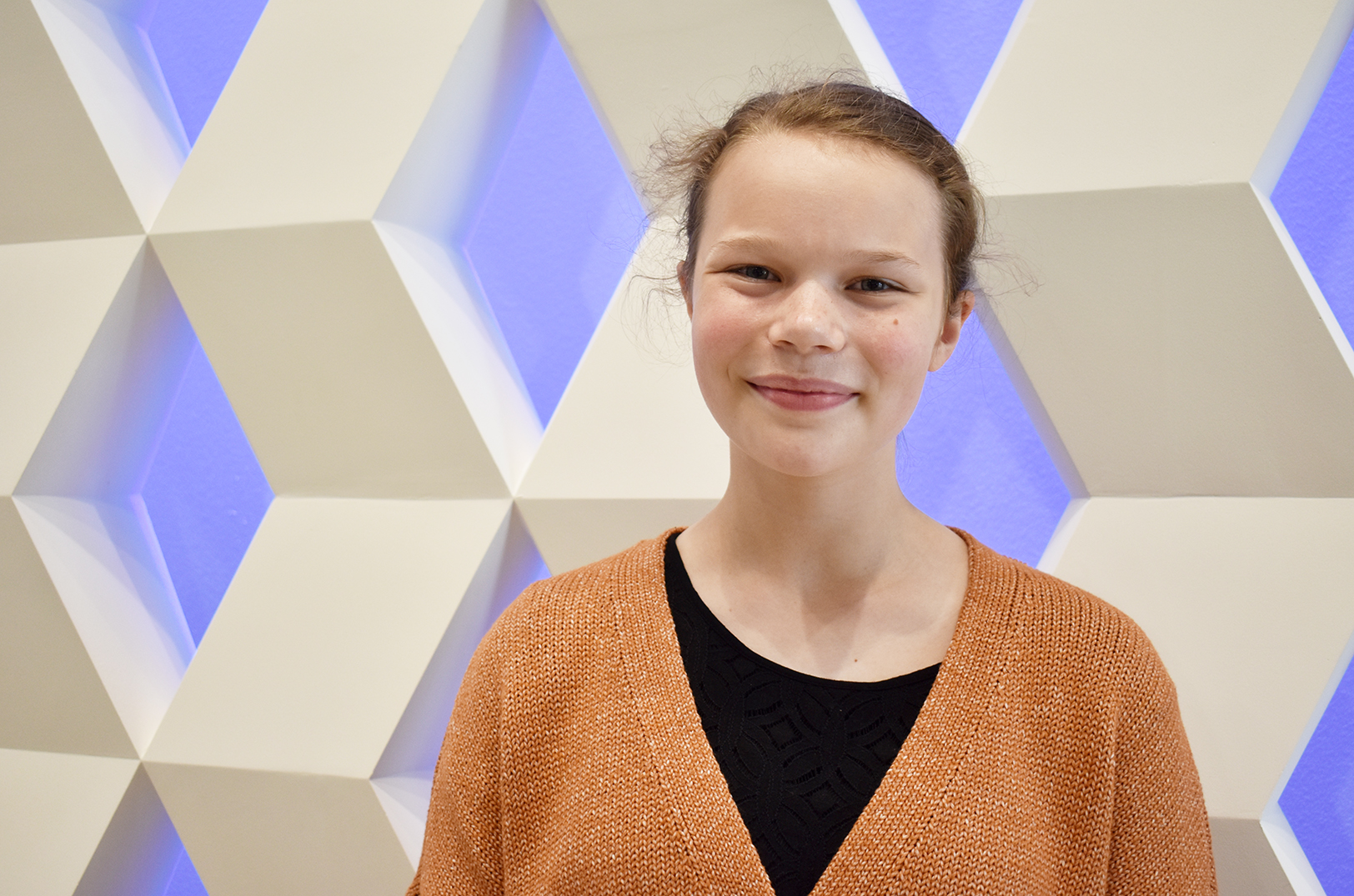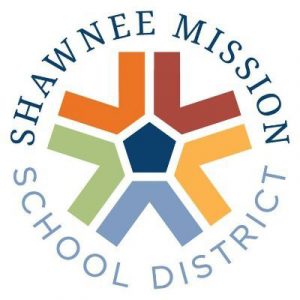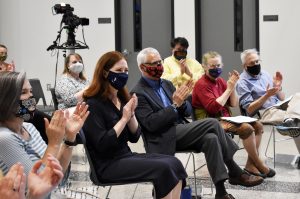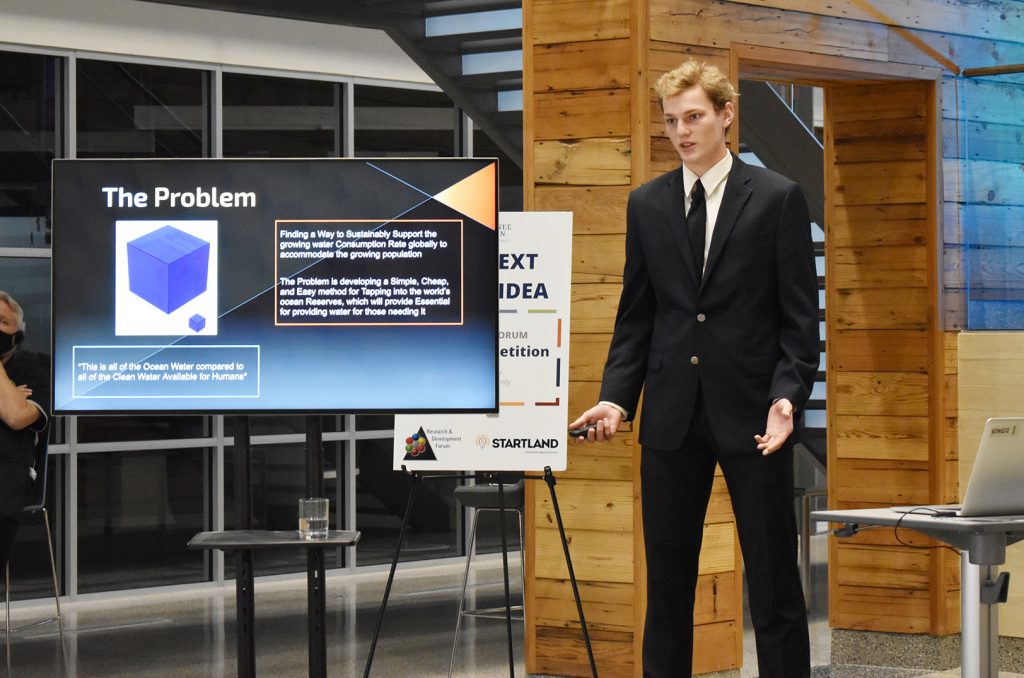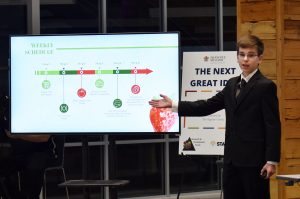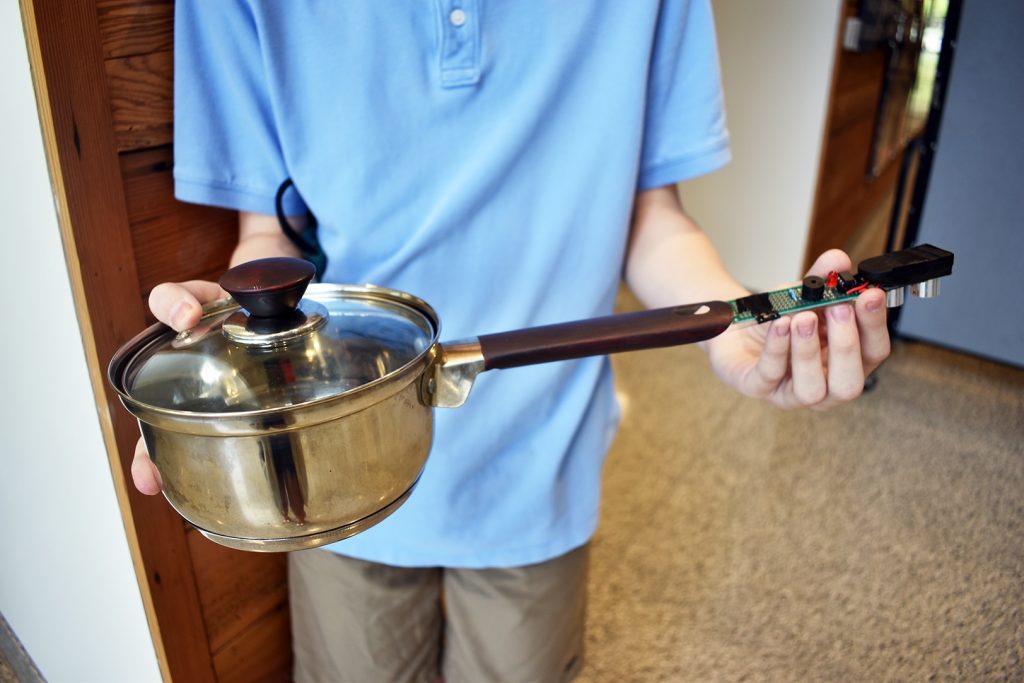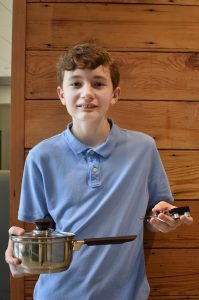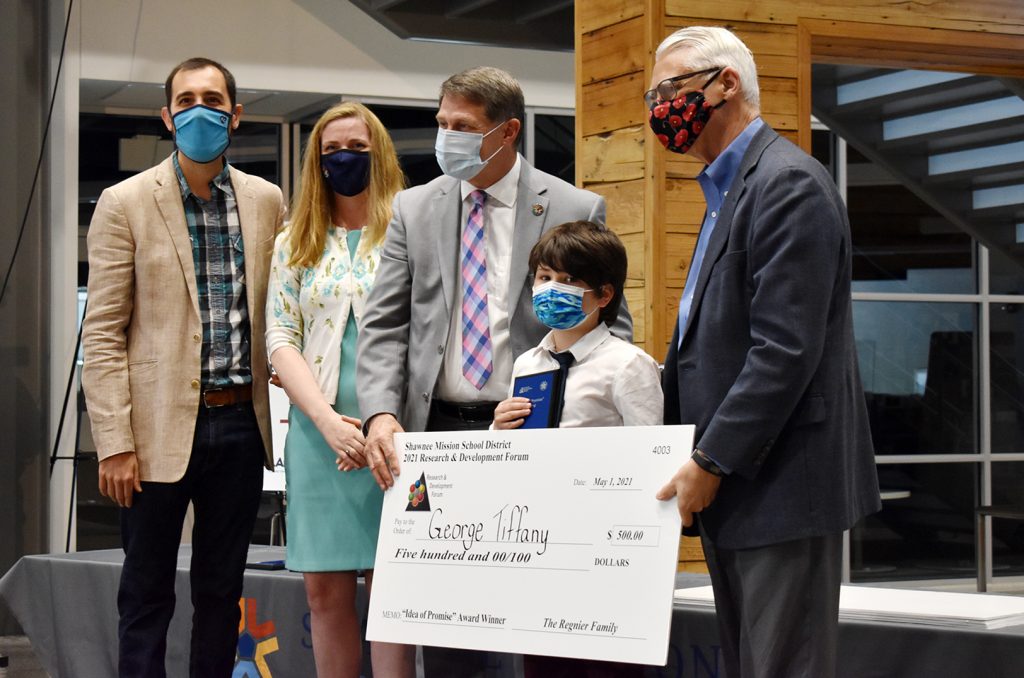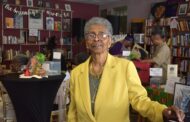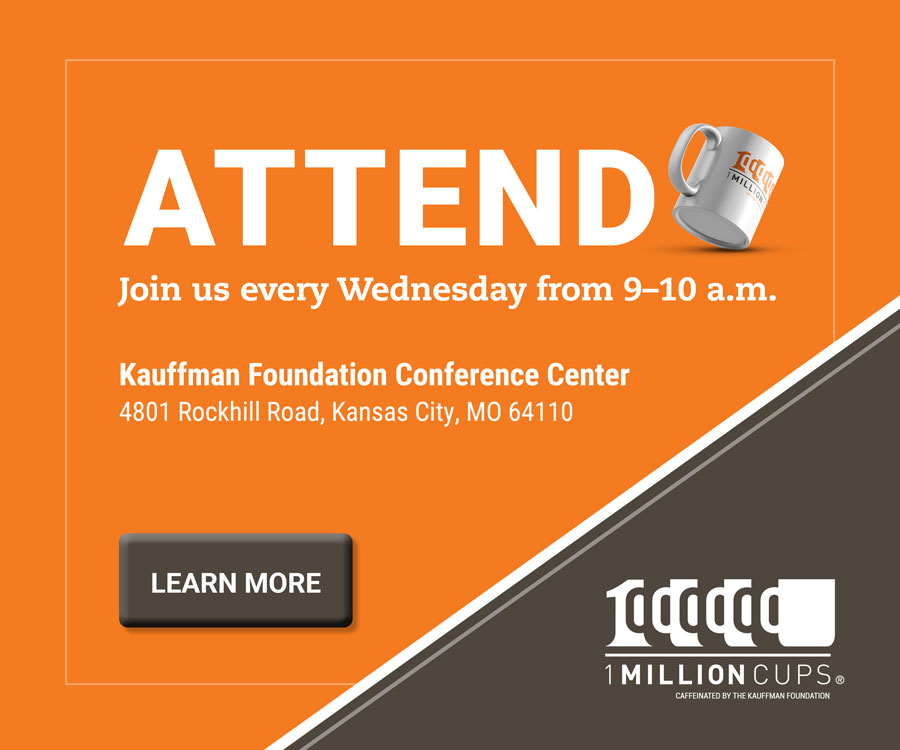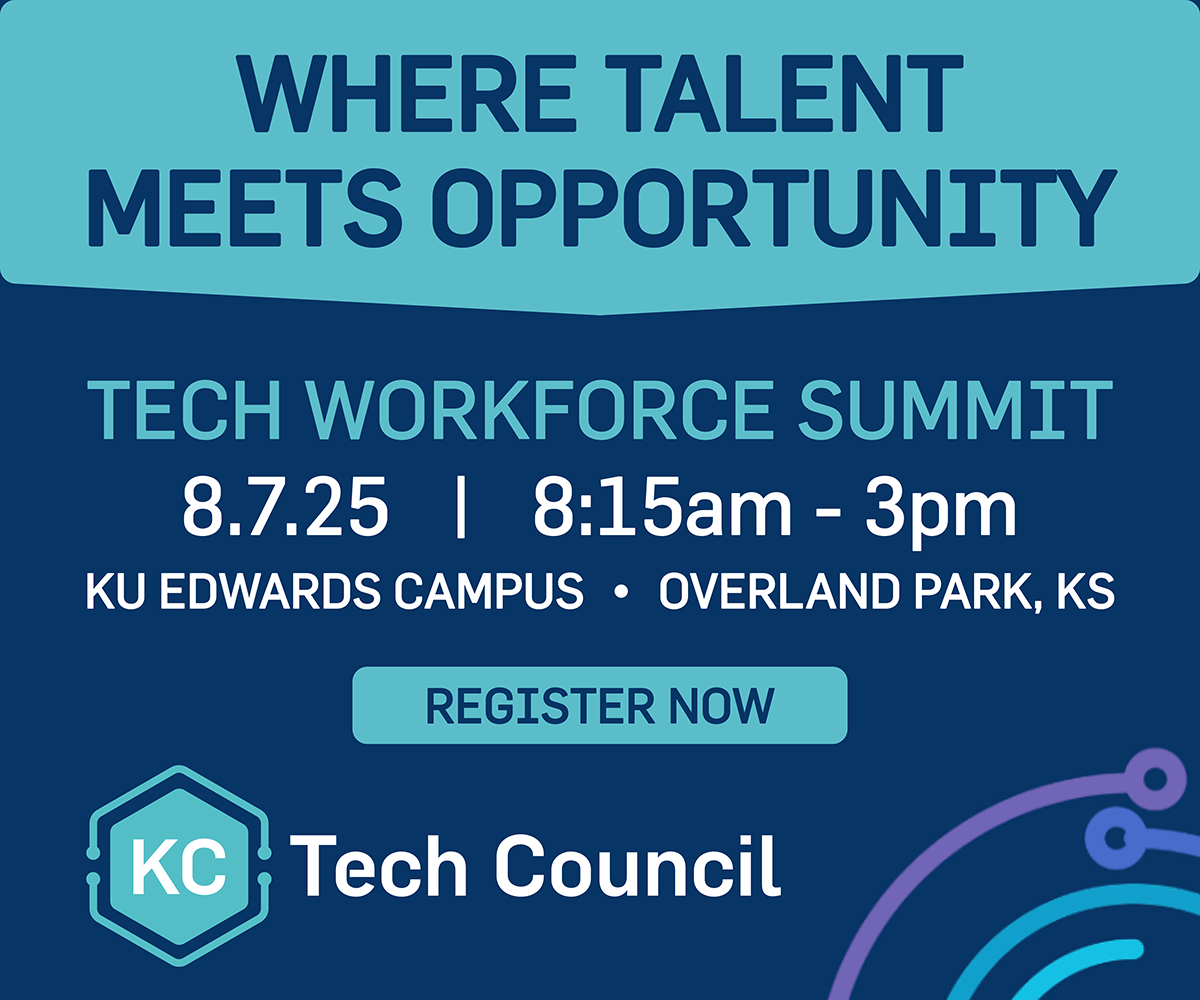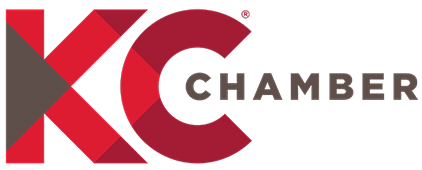Editor’s note: Startland is the parent organization of Startland News, though this report was produced independently by Startland News’ non-profit newsroom. Click here to read more about Startland’s education and real-world learning work.
Gabby Lickteig didn’t initially think of herself as an entrepreneur, she said, though the seventh grader knew she had the potential — if she could just overcome the obstacle of an unfocused presentation.
“I have a lot of ideas, but I was just bad at sharing them,” said Lickteig. “Now, I’m hoping to connect with someone to refine my design because it’s kind of bulky right now.”
The Indian Hills Middle School student ultimately was one of five winners Saturday in the Shawnee Mission School District’s first Next Great Idea pitch competition. Her project — Ficus for Clean Air — was the second pitch funded.
“I created a sustainable plant device to help clean air in classrooms,” she said, noting the help of her teacher [Jamilyn] Bertsch in formalizing her presentation.
“I was working on this project through my robotics team,” Lickteig continued. “It did really well in competitions, and I really enjoyed the project. So, I extended on our idea of a sustainable plant design.”
K-12 students in the Shawnee Mission School District were invited to compete in the contest — hosted by Startland and the Shawnee Mission Research and Development Forum, which encourages students to be innovative problem solvers.
“Young people have great ideas that deem being listened to,” said Veronica Alvidrez, who serves as the experience manager at Startland and helped design the pitch competition. “The moment students know that we acknowledge their voices and react with constructive feedback — their confidence to keep trying sets in and the learning flourishes. Suddenly taking a risk becomes a little less scary.”
In its first year, the Next Great Idea pitch competition received 84 submissions from students among various grade levels and schools within the Shawnee Mission School District (SMSD).
“Our team [at Startland] designed the experience and collaborated closely with SMSD throughout the process to ensure we were meeting the needs of students, teachers, and parents,” Alvidrez explained. “We knew building confidence and exploring ideas beyond the initial ideation stage would be skills necessary for a great pitch.”
Students began work on their pitches in early March, then used April to practice and refine their presentation before submitting a final video to judges. Startland and SMSD then dwindled the competitors down to a final eight for an in-person event Saturday at the SMSD Center for Academic Achievement on Saturday.
Finalists competed for five awards: The Next Great Idea Awards, $2,500 prize with $1500 to be used to further the idea (three winners); The People’s Choice Award, $500 prize with $400 to be used to further the idea; and the Idea of Promise Award, $500 prize with $400 to be used to further the idea.
Judges for the event included Jennie Hanna, communications and public relations manager from Fishtech Group; Melanie Haas, business technology consultant for Prairie Cube Media and Kansas Stae Board of Education member; and Thalia Cherry, founder and CEO of Cherry Co.
The event was made possible due to the Regnier family, said Mike Fulton, who serves as the superintendent in the SMSD. The Regnier family has funded the Shawnee Mission R&D Forum for the past 59 years.
“We’re just so grateful to the Regnier family, who continue to support the innovation of our students through their generosity as sponsors of this forum,” Fulton said at Saturday’s event.
The Next Great Ideas
In addition to Lickteig, 11th grader Alex Blickhan at Shawnee Mission East was awarded one of the Next Great Idea Awards for The Desalination Operation — a device he calls “The Blue House” that would desalinate ocean water to become clean drinking water.
“The goal of my project was to make [desalination] as environmentally friendly and as cheap as possible, since many other operations right now take a lot of energy to produce,” Blickhan explained. “I was trying to create one with as few moving parts as possible that would also have decent efficiency.”
The Desalination Operation took off when Blickhan used his passion for engineering to create a 3D model of his desalination device, he recalled.
“I started with just an idea, as all projects start,” the high school junior said. “I expanded on the idea by doing research; and once I thought the idea had some merit to it, I used software on our school computers to build a 3D model.”
Blickhan plans to use the prize money to improve his design, he noted.
“My main goal is to construct a scale model, because I only have it on paper and on the computer right now,” he shared. “So I need to test — what efficiency does it have? How could I redesign it to make it even more efficient, and what I could do to decrease the cost?”
Nathan Mestel, a seventh grader at Westridge Middle School, received the final Next Big Idea Award for his pitch, The Milk of Human Kindness — a nonprofit organization focused on educating the public on food waste and repurposing food waste.
“The emphasis [of The Milk of Human Kindness] is on the education aspect — sharing how food waste is a big deal and making sure that people know there are solutions out there to almost every problem concerning food waste,” Mestel said.
In his presentation, he used milk that has not yet expired (but can no longer be sold at grocery stores) as an example of repurposing food, so it does not go to waste.
“I’ve done public speaking but never presented in this fashion. It has been a valuable experience and allowed me to talk with other people,” Mestel said, noting that he connected to experts in the Kansas Department of Agriculture, the Lenexa Farmers Market and Shatto Dairy during his research.
“Now I’m thinking about, what’s my next move going to be?” the award winner shared.
Marc Janda, an eighth grader at Westridge Middle School, won the People’s Choice Award for his invention, The Safety Pot — a device that attaches to pot handles and detects when the handle is hanging over the stove. It also has a coating on the handle that will change colors when it is too hot to touch.
The invention sparked from an assignment to create something that no one has done, Janda said. The goal of The Safety Pot is to prevent kitchen accidents from parents being distracted and children pulling down the pot handle, he added.
Utilizing his passion for soldering and building, Janda created a prototype of The Safety Pot.
“It’s basically an ultrasonic sensor from an Arduino kit,” he explained. “Then there’s a battery pack on top. It’s soldered with the active buzzer light and then basically the little brain swells the resistor so the light doesn’t blow out.”
Janda plans to use his funding to create a working model of The Safety Pot, he shared.
The youngest of the finalists was George Tiffany, a second grader at Roseland Elementary. Tiffany pitched George’s Chore App — a safe application that would connect children to neighbors and friends who need assistance with various tasks.
“Hi. My name is George. I am 8 years old, and I love money,” Tiffany said, introducing his application. “But there is a problem — I am too young to get a job, and there are no safe apps for kids like me to make money. … [With this app] Neighbors get their chores done; kids get to earn money; and parents get to tire out their kids.”
Catching the attention of the judges, Tiffany received the Idea of Promise Award.
Other finalists included 12 grader at Shawnee Mission Northwest Manvir Kaur with her Dynamic Sensor; sixth grader at Highlands Elementary James Eckrich with his Safety Signal; and 12 graders at Shawnee Mission South Logan Root and Natasha Moore with The Power Walk.
Click here to watch the full Next Great Idea pitch competition event or keep scrolling to see select winning pitches.




